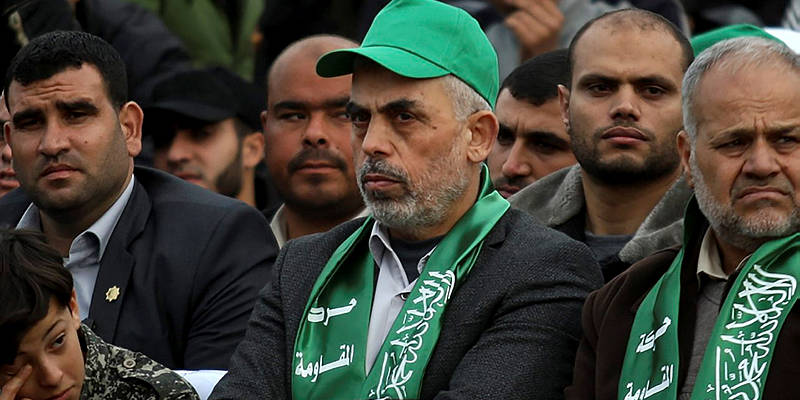A short, temporary ceasefire might be achievable, so long as it requires Hamas to release all remaining Israeli hostages.
By Con Coughlin, Gatestone Institute
For all the various efforts world leaders are investing in arranging a ceasefire between Israel and Hamas, they must understand there will be no genuine prospect of peace so long as Hamas terrorists retain control of Gaza.
Numerous options have been explored in recent weeks, ranging from the Biden administration’s wide-ranging plan to address numerous regional issues, from the threat posed by Iran to reopening negotiations on Palestinian statehood, to the recent attempt by Arab nations, led by Algeria, to pass a United Nations Security Council resolution calling for an immediate ceasefire between Israel and Hamas, which was vetoed by Washington.
US President Joe Biden’s plan for a long-term peace between Israel and the Palestinians is certainly the most comprehensive effort that has been undertaken to bring an end to the fighting in Gaza, which erupted after Hamas terrorists, on October 7, 2023, launched the most devastating terrorist attack Israel has suffered since its foundation in 1948.
In an initiative that the White House hopes could help to define Biden’s foreign policy legacy, US officials have been working on a so-called “grand bargain,” whereby a diplomatic rapprochement between Israel and Saudi Arabia would be implemented in return for the Israelis and Saudis working together to resolve the long-running Palestinian issue.
In return for Saudi Arabia agreeing to normalise diplomatic relations with Israel, thereby continuing a normalisation process initiated by the Trump administration in negotiating the Abraham Accords, Riyadh would sign a new defence pact with Washington, as well as US technical assistance on developing a domestic nuclear energy sector.
Securing agreement for the deal from Arab leaders has been the key priority of US Secretary of State Antony Blinken during his recent shuttle diplomacy mission to the Middle East.
After the Biden administration’s decidedly underwhelming performance in world affairs to date, on issues such as the chaotic withdrawal from Afghanistan, the failure of its efforts to prevent Iran from acquiring nuclear weapons capability, its absence in confronting Chinese Communist Party aggression and its constant dithering on the Ukraine conflict, it is understandable that Biden should want a genuine foreign policy breakthrough as he launches his campaign for re-election.
This has led US diplomats to intensify their efforts to implement a deal before the Muslim holy month of Ramadan commences next month.
Indeed, the Biden administration’s proposals have won widespread international backing, with many Western leaders and Arab allies supporting efforts to implement a ceasefire before the commencement of Ramadan, which is due to start on March 10.
Despite the growing international clamour for a ceasefire, which has resulted in anti-Israel demonstrations taking place in many European capitals, the prospects of lasting peace taking hold in Gaza remain as remote as ever so long as the Palestinians’ Hamas terrorist movement retains control over the territory.
Having provoked the Gaza conflict in the first place with its murderous assault on Israel on October 7, Hamas’s terrorist leadership shows no sign of backing down in their confrontation with Israel.
On the contrary, Hamas is using the remaining 136 Israeli hostages it still has — of whom at least 32 have been killed — since the October 7 attacks to blackmail Israel into making a number of outrageous concessions, such as requiring Israel to release 1,500 Palestinian prisoners — with one-third of those serving life sentences and many who have been convicted of horrendous acts of terrorism — in return for releasing the hostages.
Even Biden was forced to concede that Hamas’s demands were a “little over the top” when they first emerged earlier this month. But that has not deterred his administration’s officials from pressing on regardless with their plans to impose a ceasefire, even if Israeli Prime Minister Benjamin Netanyahu remains totally opposed to the terms of the ceasefire deal currently being presented to the Israeli cabinet.
The Israeli PM is instead concentrating his efforts on launching Israel’s long-awaited military offensive against the Hamas-controlled Rafah area of Gaza, where many of the Hamas terrorists accused of masterminding the October 7 attacks are believed still to be hiding, possibly with many of the hostages.
In anticipation of the offensive, the Israel Defense Forces (IDF) have presented Israel’s war cabinet with details of its plan to evacuate Rafah’s civilian population from Gaza.
Israel’s determination to persist with its campaign to achieve “total victory” — to use Netanyahu’s term — against Hamas has been strengthened following the IDF’s recent discoveries about the true extent of the terrorist infrastructure that Hamas, with the backing of Iran and Qatar, has managed to establish in Gaza.
Although Netanyahu recently confirmed that 75 percent of Hamas battalions in Gaza had been destroyed during the past four months of military action, IDF commanders remain concerned that the remaining battalions are hiding within Gaza’s civilian Palestinian population.
With Hamas still posing a significant terrorist threat to Israel’s security, no Israeli government will be prepared to tolerate a ceasefire agreement that allows Hamas to retain any form of presence in Gaza, a fundamental point that the Biden administration needs to take on board as it intensifies the pressure on Netanyahu’s government to accept the US ceasefire plan.
A short, temporary ceasefire might be achievable, so long as it requires Hamas to release all of the remaining Israeli hostages it is holding.
The Israeli people, irrespective of their political differences, will never accept any long-term deal that allows the terrorist masterminds of Hamas to remain in control of Gaza.
